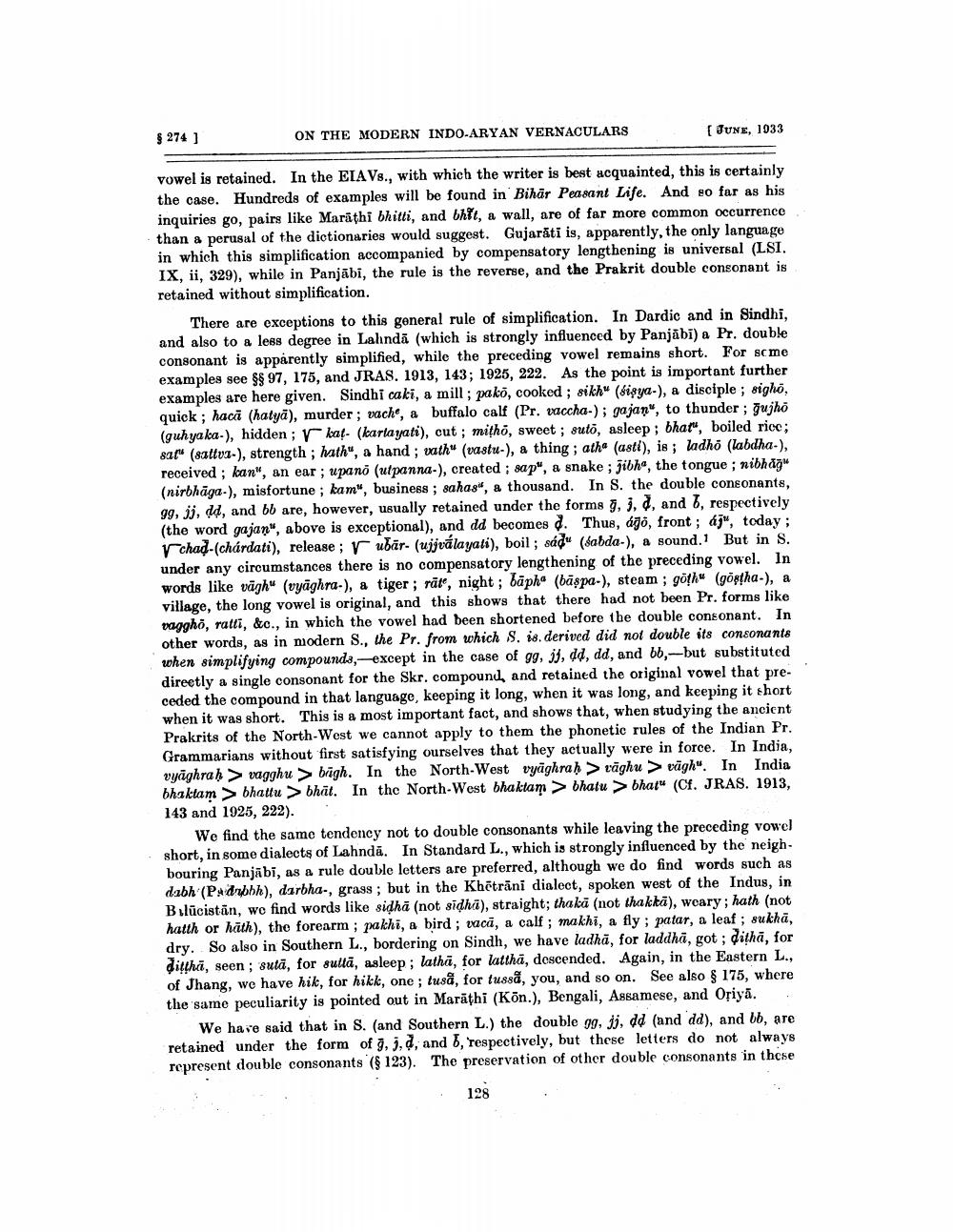________________
$ 274 ]
ON THE MODERN INDO-ARYAN VERNACULARS
(JUNE, 1033
vowel is retained. In the EIAVs., with which the writer is best acquainted, this is certainly the case. Hundreds of examples will be found in Bihar Peasant Life. And so far as his inquiries go, pairs like Marathi bhitti, and bhit, a wall, are of far more common occurrence than a perusal of the dictionaries would suggest. Gujarāti is, apparently, the only language in which this simplification accompanied by compensatory lengthening is universal (LSI. IX, ii, 329), while in Panjābi, the rule is the reverse, and the Prakrit double consonant is retained without simplification.
There are exceptions to this general rule of simplification. In Dardic and in Sindhi, and also to a less degree in Lahndā (which is strongly influenced by Panjabi) a Pr. double consonant is apparently simplified, while the preceding vowel remains short. For some examples see $$ 97, 175, and JRAS. 1913, 143; 1925, 222. As the point is important further examples are here given. Sindhi caki, a mill; pako, cooked ; sikh" (bisya-), a disciple; sigho, quick; hacă (hatyā), murder; vache, a buffalo calf (Pr. vaccha-); gajan", to thunder; gujho (guhya ka-), hidden; r kal. (karlayati), cut; mitho, sweet; suto, asleep; bhar, boiled rice; 81t* (sattva-), strength; hath", a hand; vath (vastu-), a thing; atha (ast), is ; ladho (labdha.), received ; kan", an ear; upano (utpanna.), created ; sap", a snake ; jibhe, the tongue ; nibhāg (nirbhāga-), misfortune : kam", business ; sahası, a thousand. In S. the double consonants, 99, jj, dd, and bb are, however, usually retained under the forms g. 3. d, and 6, respectively (the word gajan", above is exceptional), and dd becomes d. Thus, ágo, front; aj", today; v chad (chárdati), release ; r ubár- (ujjválayati), boil; sádu (sabda-), a sound. But in S. under any circumstances there is no compensatory lengthening of the preceding vowel. In words like vāghu (vyāghra-), a tiger ; rāt, night; bāpha (bāspa-), steam; göthu (gostha-), a village, the long vowel is original, and this shows that there had not been Pr. forms like vagghö, ratti, &c., in which the vowel had been shortened before the double consonant. In other words, as in modern s., the Pr. from which S. is derived did not double its consonants when simplifying compounds, except in the case of gg, ij, dd, dd, and bb, --but substituted directly a single consonant for the Skr. compound, and retained the original vowel that preceded the compound in that language, keeping it long, when it was long, and keeping it short when it was short. This is a most important fact, and shows that, when studying the ancient Prakrits of the North-West we cannot apply to them the phonetic rules of the Indian Pr. Grammarians without first satisfying ourselves that they actually were in force. In India, vyāghrah > vagghu > brigh. In the North-West vyāghrah > rāghu > vāgh". In India bhaktam > bhattu > bhät. In the North-West bhaktam > bhatu > bhat" (Cf. JRAS. 1913, 143 and 1925, 222).
We find the same tendency not to double consonants while leaving the preceding vowel short, in some dialects of Lahndā. In Standard L., which is strongly influenced by the neighbouring Panjabi, as a rule double letters are preferred, although we do find words such as dabh (Ps drobh), darbha-, grass; but in the Khētrāni dialect, spoken west of the Indus, in Bilūcistān, we find words like sidhā (not sidha), straight; thakā (not thakka), weary; hath (not hatth or häth), the forearm ; pakhi, a bird ; vaca, a calf; makhi, a fly; patar, a leaf ; sukhā, dry. So also in Southern L., bordering on Sindh, we have ladhā, for laddha, got; dithā, for dittha, seen; sută, for sultā, asleep; latha, for latthå, descended. Again, in the Eastern L., of Jhang, we have hik, for hikk, one; tuså, for tussä, you, and so on. See also $ 175, where the same peculiarity is pointed out in Marathi (Kõn.), Bengali, Assamese, and Oriyā.
We have said that in S. (and Southern L.) the double 99, jj, dd (and dd), and bb, are retained under the form of g, j, d, and 1, "respectively, but these letters do not always represent double consonants (8 123). The preservation of other double consonants in these
128




